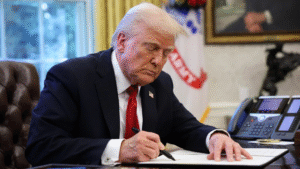U.S.-China Semiconductor War: How Chips Became the Frontline of Global Power
The U.S.-China semiconductor war has emerged as one of the most critical global tech conflicts in recent history. No longer just components in your smartphone, semiconductors are now at the heart of a power struggle that spans national security, artificial intelligence, and economic dominance.
This escalating battle over chips has deepened with new export controls, major investments, and geopolitical tension. With both nations aiming to control the future of advanced computing, the semiconductor war is shaping up to be a defining conflict of the 21st century.
Why Semiconductors Matter More Than Ever
Semiconductors power everything — from smartphones and data centers to military systems and artificial intelligence. The most advanced chips are also necessary for training large AI models, making them a strategic asset for governments.
According to Semiconductor Industry Association, the global chip industry was valued at over $600 billion in 2023. The competition to control this sector is now more than economic—it\’s existential.
U.S. Moves to Restrict China’s Access
In October 2022, the U.S. government issued sweeping export controls aimed at limiting China’s ability to acquire or develop advanced chips. These include:
- Banning the export of AI-capable chips (like NVIDIA\’s A100) to China
- Restricting U.S. talent from working with Chinese chip firms
- Preventing companies like ASML from exporting lithography tools to China
The goal: to stifle China’s growth in AI and supercomputing, which Washington views as a national security threat.
China\’s Countermoves and Self-Reliance Push
China has responded with massive state investment in its semiconductor sector. The country’s “Made in China 2025” initiative has earmarked hundreds of billions for chip R&D and manufacturing independence.
Chinese tech giant Huawei recently launched its Mate 60 Pro smartphone, powered by an advanced 7nm chip reportedly made domestically—a move seen as a breakthrough despite U.S. sanctions. This sparked backlash in Washington and renewed calls for tighter export controls.
According to Nikkei Asia, Beijing is also investing heavily in domestic equipment manufacturers to reduce reliance on U.S.-linked tech.
Implications for the Global Economy
This chip war is already affecting global supply chains:
- U.S. allies like the Netherlands, Japan, and South Korea have joined in imposing restrictions
- Taiwan, home of TSMC, remains a flashpoint in the rivalry
- Europe and India are pushing for their own semiconductor independence
Tech companies globally are adjusting sourcing strategies to mitigate risks. As tensions rise, the chip war could reshape how and where technology is developed, manufactured, and deployed.
What\’s at Stake for AI and National Security?
Advanced semiconductors enable the training of large AI models and power everything from surveillance systems to autonomous weapons. As such, controlling chip access directly influences military and cyber capabilities.
The U.S. fears that AI-accelerated chips in Chinese hands could tilt the balance of power in areas like cybersecurity, space, and battlefield automation. For China, catching up in chip tech is vital to its geopolitical strategy.
This isn’t just a trade war — it’s a battle over the technological infrastructure of global power.
Conclusion
The U.S.-China semiconductor war is no longer confined to factories or tech firms — it’s now a central issue in global politics. As both countries double down on their efforts, the rest of the world must navigate a new era of digital nationalism, decoupling, and tech sovereignty.
Whoever leads in chips will likely lead in AI, defense, and innovation. In this new Cold War of circuits and code, semiconductors are the new oil—and the race is far from over.
Sources:





Post Comment